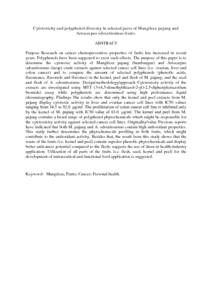Citation
Abu Bakar, Mohd Fadzelly and Mohamed, Maryati and Rahmat, Asmah and Burr, Steven A. and Fry, Jeffrey R.
(2010)
Cytotoxicity and polyphenol diversity in selected parts of Mangifera pajang and Artocarpus odoratissimus fruits.
Nutrition and Food Science, 40 (1).
pp. 29-38.
ISSN 0034-6659
Abstract
Purpose
Research on cancer chemopreventive properties of fruits has increased in recent years. Polyphenols have been suggested to exert such effects. The purpose of this paper is to determine the cytotoxic activity of Mangifera pajang (bambangan) and Artocarpus odoratissimus (tarap) crude extracts against selected cancer cell lines (i.e. ovarian, liver and colon cancer) and to compare the amount of selected polyphenols (phenolic acids, flavanones, flavonols and flavones) in the kernel, peel and flesh of M. pajang; and the seed and flesh of A. odoratissimus.
Design/methodology/approach
Cytotoxicity activity of the extracts are investigated using MTT (3‐(4,5‐dimethylthiazol‐2‐yl)‐2,5‐diphenyltetrazolium bromide) assay while polyphenols are determined using high performance liquid chromatography.
Findings
The results show that only the kernel and peel extracts from M. pajang display cytotoxic activity in liver and ovarian cancer cell lines with IC50 values ranging from 34.5 to 92.0 μg/ml. The proliferation of colon cancer cell line is inhibited only by the kernel of M. pajang with IC50 value of 63.0 μg/ml. The kernel and peel from M. pajang contains a broad range of polyphenol phytochemicals which might be responsible for the cytotoxicity activity against selected cancer cell lines.
Originality/value
Previous reports have indicated that both M. pajang and A. odoratissimus contain high antioxidant properties. This study further determines the phytochemicals profiling in both fruits, which might contribute to the antioxidant activity. Besides that, the result from this study shows that the waste of the fruits (i.e. kernel and peel) contain superior phenolic phytochemicals and display better anticancer potential compared to the flesh; suggests the use of them in health‐industry application. Utilization of all parts of the fruits (i.e. flesh, seed, kernel and peel) for the development of nutraceutical and functional food application is suggested.
Download File
![[img]](http://psasir.upm.edu.my/13863/1.hassmallThumbnailVersion/Cytotoxicity%20and%20polyphenol%20diversity%20in%20selected%20parts%20of%20Mangifera%20pajang%20and%20Artocarpus%20odoratissimus%20fruits.pdf)  Preview |
|
PDF (Abstract)
Cytotoxicity and polyphenol diversity in selected parts of Mangifera pajang and Artocarpus odoratissimus fruits.pdf
Download (296kB)
| Preview
|
|
Additional Metadata
Actions (login required)
 |
View Item |

